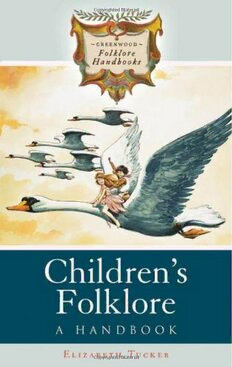
Children's Folklore: A Handbook (Greenwood Folklore Handbooks) PDF
174 Pages·2008·2.478 MB·English
Most books are stored in the elastic cloud where traffic is expensive. For this reason, we have a limit on daily download.
Preview Children's Folklore: A Handbook (Greenwood Folklore Handbooks)
Description:
Children have their own games, stories, riddles, and so forth. This book gives students and general readers an introduction to children's folklore. Included are chapters on the definition and classification of children's folklore, the presence of children's folklore in literature and popular culture, and the scholarly interpretation of children's folklore. The volume also includes a wide range of examples and texts demonstrating the variety of children's folklore around the world.Children have always had their own games, stories, riddles, jokes, and so forth. Many times, children's folklore differs significantly from the folklore of the adult world, as it reflects the particular concerns and experiences of childhood. In the late 19th century, children's folklore began receiving growing amounts of scholarly attention, and it is now one of the most popular topics among folklorists, general readers, and students. This book is a convenient and authoritative introduction to children's folklore for nonspecialists.The volume begins with a discussion of how children's folklore is defined, and how various types of children's folklore are classified. This is followed by a generous selection of examples and texts illustrating the variety of children's folklore from around the world. The book then looks at how scholars have responded to children's folklore since the 19th century, and how children's folklore has become prominent in popular culture. A glossary and bibliography round out the volume.
See more
The list of books you might like
Most books are stored in the elastic cloud where traffic is expensive. For this reason, we have a limit on daily download.
